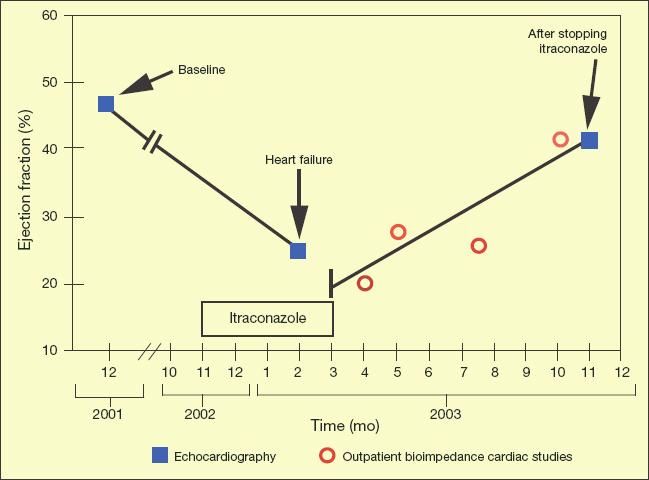Life-Threatening Heart Failure Associated With Itraconazole
Life-threatening heart failure associated with itraconazoleantifungal therapy developed in a patient with disseminatedCoccidioides immitis infection. This was documented bycardiac studies that demonstrated a deterioration of cardiacfunction during therapy and an improvement after itraconazoletherapy was discontinued. Heart failure associatedwith itraconazole can be missed by those unfamiliar with thiscomplication. In any patient with a fungal infection who isbeing treated with itraconazole, this serious complication canoccur; however, it can be reversible with discontinuation ofthe drug. [Infect Med. 2008;25:292-293]
Itraconazole is a widely used antifungal agent. Heart failure is a suspected complication of its use.1 We treated a patient with disseminated Coccidioides immitis infection with oral itraconazole; however, life threatening heart failure developed after 4 months of therapy. The heart failure improved after discontinuation of the antifungal.
Case report
In May 2002, a disseminated pulmonary infection attributed to C immitis was diagnosed in a previously healthy 44-year-old man of African American descent. Diagnosis was confirmed by isolation of the organism and positive serological test results. The patient was initially treated with amphotericin B followed by oral fluconazole. The infection was complicated by dissemination to the spine. In October 2002, the patient underwent spinal surgery to debulk infection and stabilize the spine. The patient was treated postoperatively with intravenous liposomal amphotericin B, and a clinical improvement was seen.
By November 2002, the C immitis infection was controlled. The patient was switched to oral itraconazole, 100 mg bid. Four months later, in February 2003, the patient was hospitalized for heart failure, which was treated with standard measures. The patient improved. Catheterization of the left side of the heart was performed and showed normal coronary arteries and normal ventricular contractility. An echocardiogram showed an ejection fraction of 26%. There was no evidence of active C immitis infection, and when the patient was discharged, itraconazole was prescribed at the same dosage that the patient already had been receiving (100 mg bid).
In March 2003, the patient was again admitted with signs and symptoms of heart failure. This time, he required intubation and mechanical ventilation. Heart failure improved, and the patient was extubated. He had no peripheral edema or gallop rhythm. Itraconazole therapy was considered a potential cause of heart failure, and it was discontinued. The patient's medication was switched to oral fluconazole 400 mg daily, and he was discharged.
The Figure shows changes in ejection fraction during 4 months of itraconazole use before the development of heart failure. At the time of hospitalization for heart failure in February 2003, the ejection fraction was 26%, which was established by a cardiac catheterization. Improvement in ejection fraction to 47% was documented by an echocardiogram in November 2003, 8 months after itraconazole therapy was discontinued. In addition to echocardiograms, outpatient bioimpedance cardiac studies during follow-up also demonstrated a gradual improvement in ejection fraction.2

Figure -
Relationship of ejection fraction, heart failure, and itraconazole.
Discussion
There are sparse data on the relationship between itraconazole and heart failure. One publication reviewed 58 cases reported to the FDA.1 Twenty eight (48%) of these patients were hospitalized and remarkably, 13 (22%) died. However, the causal relationship between itraconazole and heart failure was not clearly established because most of the patients described in that report represented complicated cases. The patients were very ill and were receiving a variety of medications in addition to itraconazole. Our patient received itraconazole alone for 4 months before being hospitalized for heart failure.
Itraconazole is thought to have better bone penetration than other antifungal azoles and was chosen because our patient had multiple bone lesions attributed to C immitis infection. 3 The patient's situation provided us with an observational study over time that documented a relationship between heart failure and itraconazole therapy for management of a C immitis infection. The only medication taken by this patient before his first episode of heart failure was itraconazole. He continued to take itraconazole after his initial discharge because the possible association between this therapy and heart failure had not yet been recognized. Our patient illustrates the importance of recognizing this potential complication and of ascertaining that heart failure may be an adverse effect of itraconazole therapy and not a preexisting condition or a complication of the underlying fungal infection.
There does not appear to be a similar association between heart failure and other azole antifungals. The mechanisms through which itraconazole causes heart failure are unknown, but negative inotropic effects are postulated.1 Itraconazole given to healthy volunteers caused a transient asymptomatic decrease in left ventricular ejection fraction. 4 It should be noted that calcium channel blockers also can have negative inotropic effects, and their use in management of itraconazole-associated heart failure theoretically could be additive, potentially worsening the heart failure.
Physicians should maintain a high index of suspicion for heart failure in patients taking itraconazole.
References:
- Ahmad SR, Singer SJ, Leissa BG. Congestive heart failure associated with itraconazole. Lancet. 2001;357:1766-1767.
- Parrott CW, Burnham KM, Quale C, Lewis DL. Comparison of changes in ejection fraction to changes in impedance cardiography cardiac index and systolic time ratio. Congest Heart Fail. 2004;10(2 suppl 2):11-13.
- Galgiani JN, Catanzaro A, Cloud GA, et al. Comparison of oral fluconazole and itraconazole for progressive nonmeningeal coccidioidomycosis: a randomized, double-blind trial. Mycoses Study Group. Ann Intern Med. 2000;133:676-686.
- Sporanox (itraconazole) [package insert]. Titusville, NJ: Janssen Pharmaceuticals; 2004.